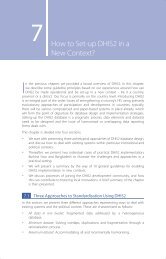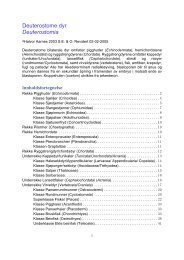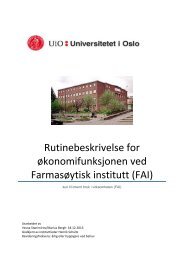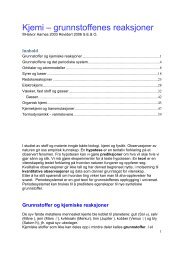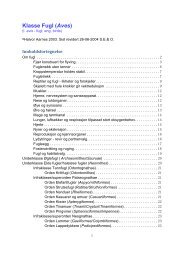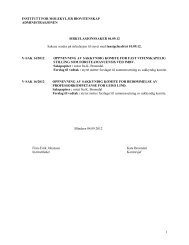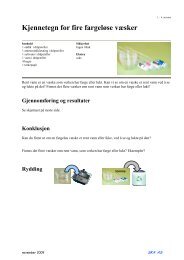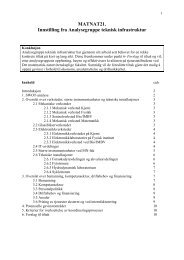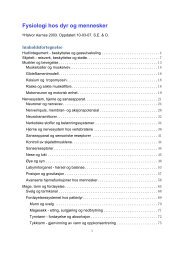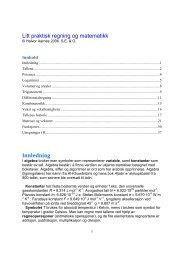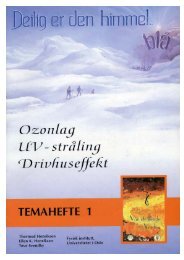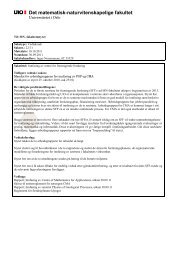Allyl type radical formation in X-irradiated glutarimide crystals ...
Allyl type radical formation in X-irradiated glutarimide crystals ...
Allyl type radical formation in X-irradiated glutarimide crystals ...
You also want an ePaper? Increase the reach of your titles
YUMPU automatically turns print PDFs into web optimized ePapers that Google loves.
e determ<strong>in</strong>ed. 13 The fit was done simultaneously for j ¼ 1to3to obta<strong>in</strong> the tensor. Spectrum simulations were made us<strong>in</strong>gthe program KVASEC, as described previously. 14 Crystallographiccoord<strong>in</strong>ates were calculated us<strong>in</strong>g a modified versionof the crystallographic data program ORFEE, 15 complementedby locally developed programs.The DFT calculations were performed us<strong>in</strong>g the GAUS-SIAN98 program package. 16 The s<strong>in</strong>gle po<strong>in</strong>t calculationsused the B3LYP hybrid functional and the 6-311þG(2df,p)basis set based on an optimized structure evaluated us<strong>in</strong>gthe 6-31þG(d) basis set us<strong>in</strong>g a start<strong>in</strong>g geometry obta<strong>in</strong>edfrom the X-diffraction data. 10Fig. 1 (a) The <strong>glutarimide</strong> structure viewed down hci. Broken l<strong>in</strong>es<strong>in</strong>dicate hydrogen bonds. Only C3=O1 participates <strong>in</strong> hydrogen bond<strong>in</strong>g,to N1–H of a neighbor<strong>in</strong>g molecule around a centre of symmetry.(b) A view of the <strong>glutarimide</strong> molecule, depict<strong>in</strong>g the half chair con<strong>formation</strong>around the C3 atom.The EPR, ENDOR and ENDOR-<strong>in</strong>duced EPR (EIE) spectrawere recorded us<strong>in</strong>g an X-band Bruker ESP300E spectrometerequipped with a microwave frequency counter andNMR gaussmeter. The temperature was controlled us<strong>in</strong>g aBRUKER ER 4112 variable temperature control unit. ForENDOR experiments, BRUKER’s DICE technology for generationof the rf-field <strong>in</strong> comb<strong>in</strong>ation with the BRUKERENDOR cavity (TM 110 ) was employed together with a 200W ENI rf-amplifier. The system was set to generate a rf-fieldsquare-wave-like frequency modulation of the rf-field at12.5 kHz with a modulation depth of typically 140 kHz.The ENDOR signal <strong>in</strong>tensity was first <strong>in</strong>vestigated at differenttemperatures and it was noted that for the present systemthe ENDOR enhancement showed a maximum at 150 K.The measur<strong>in</strong>g temperature was hence chosen to be 150 K.The ENDOR frequency n M depends on the orientation ofthe magnetic field l ¼ B/B and is given by 11n 2 M ¼ l M Mg gA n N1g Ag nN1l ð1ÞIt conta<strong>in</strong>s contributions from the hyperf<strong>in</strong>e tensor A and fromthe nuclear Zeeman term n N ¼ g N m N B/h, both given <strong>in</strong> frequencyunits. 1 is the unit tensor, and M ¼ 1 2is the electronicquantum number. A QuickBasic program allow<strong>in</strong>g the evaluationof g- and A-tensors from EPR s<strong>in</strong>gle crystal measurementsby non-l<strong>in</strong>ear or l<strong>in</strong>ear least squares fits to eqns. (1) or (2), wasused to derive the proton hfc tensors from the ENDOR data.In general, a non-l<strong>in</strong>ear least squares fit has to be employed toextract the tensor elements of A, assumed to be symmetric, butdue to the small g-anisotropy a l<strong>in</strong>ear procedure was sufficient.The hyperf<strong>in</strong>e tensor of each coupl<strong>in</strong>g was accord<strong>in</strong>gly obta<strong>in</strong>ableby the method of Schonland, 12 adopt<strong>in</strong>g the expression:n 2 M ¼ a j þ b j cos 2y þ c j s<strong>in</strong> 2yThe measured ENDOR frequencies depend<strong>in</strong>g on magneticfield orientation y <strong>in</strong> the three different planes ( j) wereemployed to calculate the values of a j , b j and c j that are l<strong>in</strong>earfunctions of the elements of the hyperf<strong>in</strong>e coupl<strong>in</strong>g tensor A toð2Þ3. ENDOR resultsThe EPR spectra obta<strong>in</strong>ed after irradiation at 295 K andrecorded at 150 K were difficult to <strong>in</strong>terpret and analyze dueto a large number of overlapp<strong>in</strong>g resonance l<strong>in</strong>es from severaldifferent <strong>radical</strong> species. In contrast, the ENDOR spectraobta<strong>in</strong>ed at 150 K revealed a number of well-resolved resonancel<strong>in</strong>es with different <strong>in</strong>tensities. This is illustrated <strong>in</strong>Fig. 2, where the ENDOR l<strong>in</strong>es account<strong>in</strong>g for the previouslyreported <strong>radical</strong>s I and II are clearly shown (a I , b I1 , b I2 anda II , b II1 , b II2 ).z This ENDOR spectrum is recorded with theexternal magnetic field parallel to ha*i. New resonance l<strong>in</strong>es,not previously detected at room temperature were clearlyobservable <strong>in</strong> the spectrum at 150 K. Based on the experimentalresults presented below it has been concluded that thesel<strong>in</strong>es are due to a new <strong>radical</strong> species denoted III, and the resonancel<strong>in</strong>es are given the symbols a III1 and a III2 . Additionall<strong>in</strong>es were observed <strong>in</strong> the 15–22 MHz range. They were difficultto follow, and could not be unambiguously attributed to aparticular species. The significant l<strong>in</strong>e broaden<strong>in</strong>g observed forthe two b-protons of <strong>radical</strong> II may be due to the dynamics<strong>in</strong>volved <strong>in</strong> this system. Different dynamical models were discussed<strong>in</strong> our previous paper. 5 The dynamics is not discussed<strong>in</strong> the present work.Figs. 3a–cz show the dependence of the ENDOR resonancefrequencies measured at 150 K with the angle of rotation of theFig. 2 ENDOR spectrum of a <strong>glutarimide</strong> s<strong>in</strong>gle crystal X-<strong>irradiated</strong>at 295 K and recorded at 150 K with the static magnetic field parallelto ha*i. L<strong>in</strong>es a I , b I1 , b I2 belong to <strong>radical</strong> I; l<strong>in</strong>es a II , b II1 , b II2 are dueto <strong>radical</strong> II; l<strong>in</strong>es a III1 , a III1 have been assigned to <strong>radical</strong> III. L<strong>in</strong>emarked by arrow could not be analyzed.z An ENDOR l<strong>in</strong>e is superscripted with þ if it the transition orig<strong>in</strong>sfrom the M ¼ 1/2 manifold of states, and with if it orig<strong>in</strong>s fromthe M ¼ 1/2 manifold.This journal is Q The Owner Societies 2004 Phys. Chem. Chem. Phys., 2004, 6, 3604–3610 3605





